Jessica100
Rough_Rock
- Joined
- May 4, 2024
- Messages
- 1
I have an engagement ring with a 2.4 carat natural brilliant cut diamond. The clarity of the diamond is VVS2 and the color is J.
I noticed a few days ago when I rotated the ring on my fingers against the sunlight that a blue area appeared in the center of the diamond when the diamond was in a certain position. When I turned the ring the other way, the blue area was no longer visible. But, when I turned the ring a bit, the blue area changed its shape somewhat.
I read on the Diamond Mansion website that: ”Diamonds with VERY STRONG fluorescence will appear somewhat blue under DIRECT sunlight.” I also read on Brilliance's website that: ”Fluorescence can be visible to the naked eye under certain lighting conditions. Diamonds with a strong or very strong fluorescence rating will usually glow blue under UV lights (outdoors in the sun or office lighting, for example).” The GIA website also states that: ”Some diamonds fluoresce when they are exposed to long-wave ultraviolet (UV) rays from sources like the sun. This can cause them to emit a bluish light…”
My diamond's quality analysis report says: "Fluorescence: STL". Does anyone know what this means as I don't understand it myself so I'm not sure if my diamond has strong or very strong fluorescence.
I also read on the internet that a diamond will only fluoresce if there were traces of the element boron present in the earth when the diamond was undergoing the process of crystallization. Based on a study by GIA, about 25 % to 35 % of natural diamonds exhibit some degree of fluorescence, but only 10 % are of medium to very strong intensity. I read on The Gem Academy's website that: ”Natural diamonds containing boron are exceptionally rare, accounting for less than 0.01 %.” The GIA website also states that: ”The presence of boron as an impurity in natural diamond is rare, as the amount of uncompensated boron found is typically less than 0.5 ppm.”
I also read on the Ouros Jewels website that: ”Natural diamonds are found in mines, and they don’t face the pressure level of lab-grown diamonds. But natural diamonds tolerate higher pressure than lab diamonds from the digging machines in the mines. The pressure of the machine hits the surface of the natural diamond and leaves the signature blue color, and it is called a "blue nuance diamond."”
However, I don't think my diamond has a blue nuance because of the boron or the digging machine because it doesn't look like it. I did notice a hint of blue in my diamond twice when I photographed the ring outside, but I think the blue color was due to the reflection of the sky. My diamond is yellowish in color, but in some lighting it sometimes looks whiter.
Does anyone have any ideas why the blue color appears in the diamond? And does it in any way affect the value of the diamond?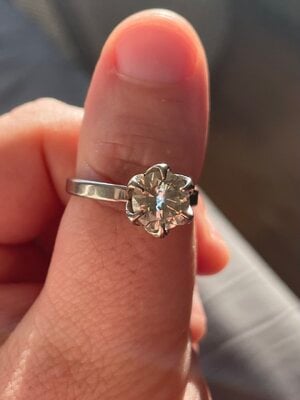
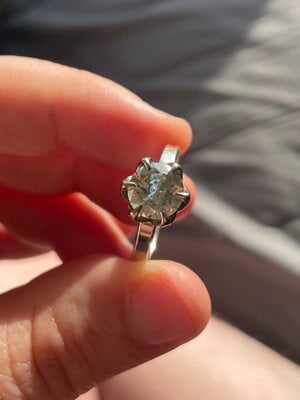
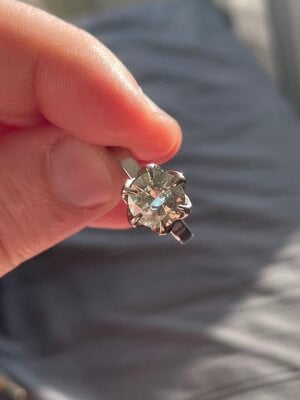
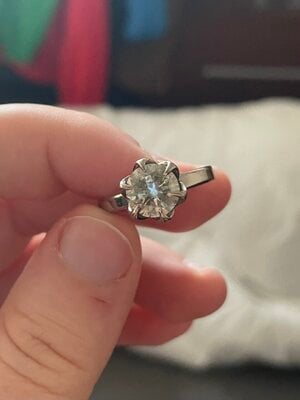
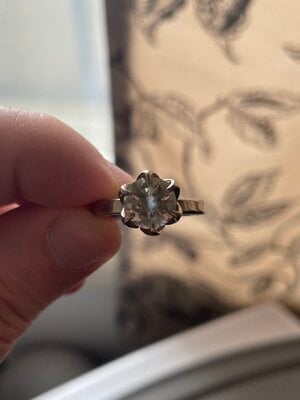
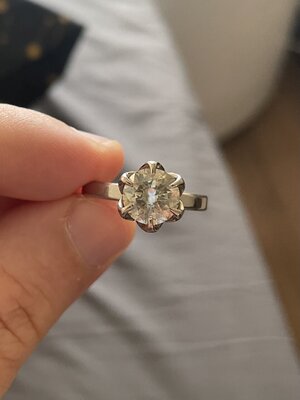
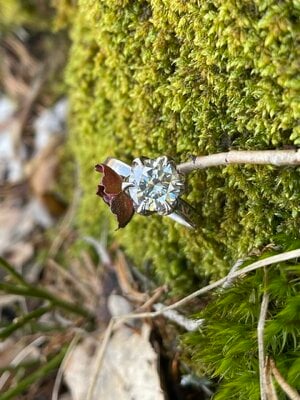
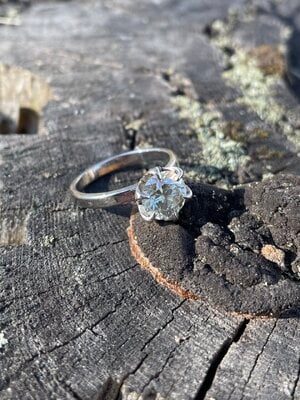
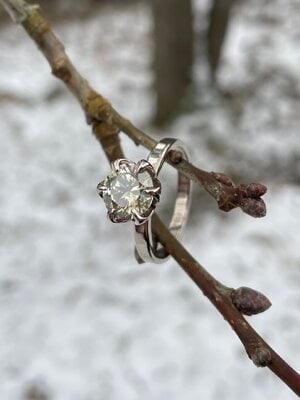
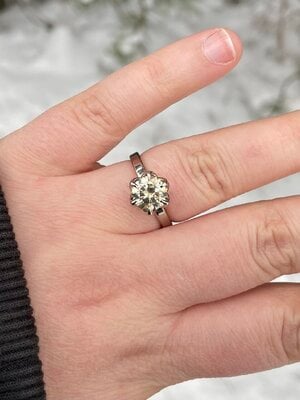
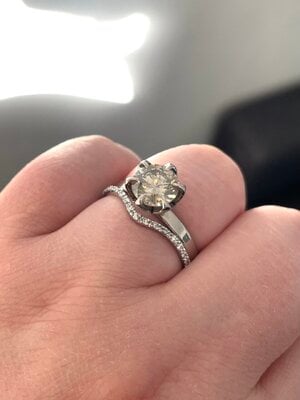
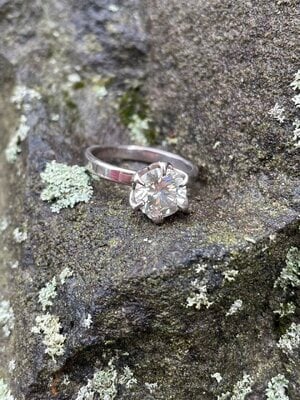
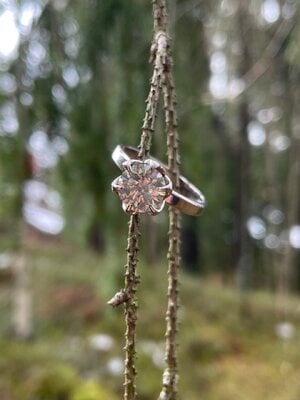
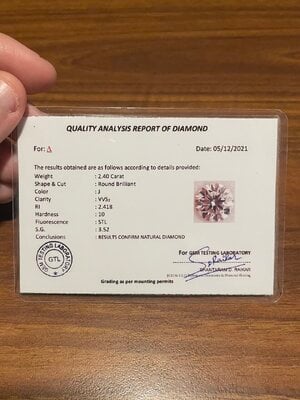
I noticed a few days ago when I rotated the ring on my fingers against the sunlight that a blue area appeared in the center of the diamond when the diamond was in a certain position. When I turned the ring the other way, the blue area was no longer visible. But, when I turned the ring a bit, the blue area changed its shape somewhat.
I read on the Diamond Mansion website that: ”Diamonds with VERY STRONG fluorescence will appear somewhat blue under DIRECT sunlight.” I also read on Brilliance's website that: ”Fluorescence can be visible to the naked eye under certain lighting conditions. Diamonds with a strong or very strong fluorescence rating will usually glow blue under UV lights (outdoors in the sun or office lighting, for example).” The GIA website also states that: ”Some diamonds fluoresce when they are exposed to long-wave ultraviolet (UV) rays from sources like the sun. This can cause them to emit a bluish light…”
My diamond's quality analysis report says: "Fluorescence: STL". Does anyone know what this means as I don't understand it myself so I'm not sure if my diamond has strong or very strong fluorescence.
I also read on the internet that a diamond will only fluoresce if there were traces of the element boron present in the earth when the diamond was undergoing the process of crystallization. Based on a study by GIA, about 25 % to 35 % of natural diamonds exhibit some degree of fluorescence, but only 10 % are of medium to very strong intensity. I read on The Gem Academy's website that: ”Natural diamonds containing boron are exceptionally rare, accounting for less than 0.01 %.” The GIA website also states that: ”The presence of boron as an impurity in natural diamond is rare, as the amount of uncompensated boron found is typically less than 0.5 ppm.”
I also read on the Ouros Jewels website that: ”Natural diamonds are found in mines, and they don’t face the pressure level of lab-grown diamonds. But natural diamonds tolerate higher pressure than lab diamonds from the digging machines in the mines. The pressure of the machine hits the surface of the natural diamond and leaves the signature blue color, and it is called a "blue nuance diamond."”
However, I don't think my diamond has a blue nuance because of the boron or the digging machine because it doesn't look like it. I did notice a hint of blue in my diamond twice when I photographed the ring outside, but I think the blue color was due to the reflection of the sky. My diamond is yellowish in color, but in some lighting it sometimes looks whiter.
Does anyone have any ideas why the blue color appears in the diamond? And does it in any way affect the value of the diamond?

















300x240.png)